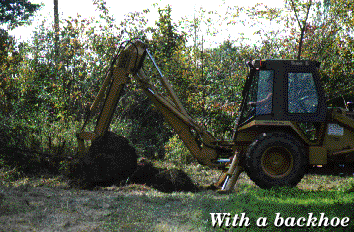 The Dig
The Dig
 The Dig
The Dig
Museum workers knew that establishing the location of the original discovery site would not necessarily lead to finding more bones. They knew that the majority of the original bones were collected by Thompson in 1849 and that any pieces left behind were certainly destroyed during railroad construction.
Knowing the location of the find however, it was now possible to look for other evidence that might lie at the same stratigraphic level. Might there be other whales? Fish or other vertebrates from the Champlain Sea? What microfossils might be find in the sediments? And what stories might the sediments themselves tell?
It was decided to return to the site, move approximately 100 feet west of the tracks (to assure strata undisturbed by the railroad), and dig another hole.
But first there were arrangements that needed to be made: The local property owner must be contacted so that permission to dig on his property could be obtained. (The property owner, a farmer, asked only that the digging wait until he harvested his last crop of alfalfa.) Dig-Safe, a national excavation hot-line was also contacted to guarentee that no buried cables were located in the vicinity of the dig.
With these arrangements completed, the digging could begin.
 owned and operated by a local resident, an approximately 14' deep hole was quickly opened. Material brought up by the machine was at first a rich dark soil containing abundant organic material which changed rapidly to a silty sand once the "plow zone", or layer affected by recent farming activities was passed This silty sand gave way to a thick pasty blue grey clay at a depth of about 5-6 feet. Tiny white fragments of shells appeared periodically in the clay along with rounded pebbles and small cobbels.
owned and operated by a local resident, an approximately 14' deep hole was quickly opened. Material brought up by the machine was at first a rich dark soil containing abundant organic material which changed rapidly to a silty sand once the "plow zone", or layer affected by recent farming activities was passed This silty sand gave way to a thick pasty blue grey clay at a depth of about 5-6 feet. Tiny white fragments of shells appeared periodically in the clay along with rounded pebbles and small cobbels.
Once the hole was dug, a ladder was dropped into the excavation and museum workers descended, cautiously at first, to examine the exposed strata and to look for evidence of fossils.
After a tape measure was secured at ground level to provide a reference point for further observations, a detailed description of the stata was begun starting at the top (gound level) and working down through the hole towards the dark sticky clay that lie at the bottom. In this description, changes in color, grain size, organic content and other factors were noted. These notes would eventually be combined with photographs and drawings made at the site to compile a "Stratigraphic section". That stratigraphic section is shown here.
In addition to the visual and written observations that were recorded by museum workers, soil samples were carefully collected every 6" in depth from 1' - 14'. It was hoped that these samples might contain evidence in the form of microscopic fossils such as foraminiferans, ostracods and pollen grains that would help define the series of events that have taken place in the approximately 11,000 years since the whale died. The foraminiferans and ostrocods would give clues to the changing temperatures and salinities of the waters while the pollen grains might indicate changes taking place in plant communities on land.
Once collected, these samples would be returned to the laboratory where they would be carefully analyzed for microfossil content as well as significant changes in the ratio of sand to silt to clay, an important clue in determining how the sediments were originally deposited.
Return to Directory of Exhibits or UVM Home Page.
__________________________________________________________________
Send questions, comments, changes, and additions to Wesley.Wright@uvm.edu and jefflhowe@verizon.net